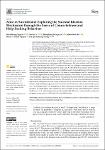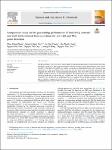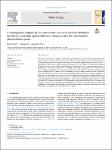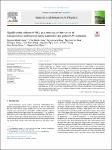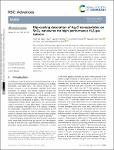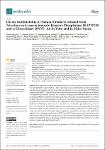Search
Author
- Quan-Hoang Vuong (27)
- Anh-Tuan Le (17)
- Vuong QH (12)
- Anh D. Phan (11)
- next >
Subject
- Electrospinning (8)
- Nanoparticles (6)
- Compound droplet (5)
- Machine learning (5)
- next >
Date issued
- 2020 - 2022 (485)
- 2010 - 2019 (19)
- 2002 - 2009 (2)
Has File(s)
Search Results
Effect of non-canonical scalar fields on the CMB imprints of the anisotropic inflation will be discussed in details in this paper. In particular, we are able to obtain the general formalism of the angular power spectra in the scalar perturbations, tensor perturbations, cross-correlations, and linear polarization in the context of the anisotropic inflation model involving non-canonical scalar fields. Furthermore, some significant numerical spectra will be plotted using the most recent data of Planck as well as the BICEP2 and Keck array. As a result, we find a very interesting point that the TT spectra induced by the tensor perturbations as well as by the linear polarization will increase when the speed of sound decreases. |
Nanofibers of ZnO-SnO2 nanocomposites doped with Au crystals were synthesized by an electrospinning method for enhancement of H2S gas sensing performance. The mixed solution of zinc acetate dihydrate and tin(II) chloride dihydrate, dissolved in ethanol/DMF solvent, was spun directly on the interdigital Pt electrodes for sensor fabrication. Thermal treatment was carried out to convert the spun nanofibers into ZnO-SnO2 nanocomposites doped with Au crystals. SEM and TEM observation confirmed the formation of porous nanofibers with an average diameter of about 120 nm. X-ray diffraction studies revealed that the nanocomposites of ZnO and SnO2 phases were formed, but not ZnSnO3, despite the precursor solution being mixed on the atomic scale from the starting solution. Doping with 0.001, 0... |
On average, one person dies by suicide every 40 s. However, extant studies have largely focused on the risk factors for suicidal behaviors, not so much on the formation of suicidal thoughts. Therefore, we attempt to explain how suicidal thoughts arise and persist inside one’s mind using a multifiltering information mechanism called Mindsponge. Bayesian analysis with Hamiltonian Markov Chain Monte Carlo (MCMC) technique was run on a dataset of multinational students (N = 268) of an international university in Japan. Item 9 in the PHQ-9 was used to survey suicidal ideation. The associations among four main variables, namely, (i) suicidal ideation, (ii) help-seeking willingness (informal and formal sources), (iii) sense of connectedness, and (iv) information inaccessibility (represente... |
The design of hetero-nanojunctions can greatly amplify the gas-sensing performance of conventional metal oxide gas sensors. In this study, the composite nanofibers (NFs) of ZnO–SnO2 internal heterojunctions (HJs) and the mixed NFs of ZnO/SnO2 external HJs were realized by using the electrospinning technique. Then, the gas-sensing characteristics of the as-synthesized NFs toward H2S and NO2 gases were systematically investigated and compared. The effects of the internal and external nanojunctions of the hetero-NF-based gas sensors were also explored. Results showed that the ZnO–SnO2 composite NFs demonstrate a higher response than those of the ZnO/SnO2 mixed NFs, as well as bare ZnO and SnO2 NFs. Also, the cross responses of the hetero-NF sensors toward 200 ppm CO, 250 ppm H2, and 25... |
We devise an implicitly new design for boosting the light uniformity in the concentrated photovoltaics (CPV) system, whereby addressing the overheating issue of the PV cell and enhancing the electrical cell efficiency. Rather than using a well-known system of the Cassegrain concentrator design, consisting of double mirrors + a homogeniser, in this study, we mimic a structure of crustacean’s eyes for a design of homogeniser, consisting of an array of a mirror channel. Such proposed design allows making use of only a primary parabolic mirror + a homogeniser to concentrate and redistribute the sunlight, representing a large departure from virtually all of the previous studies. Specifically, such homogeniser can furcate the light beam into the small channels/trenches, redirect the light... |
A unique combination of high response and fast response-recovery is still a challenge in the development of room-temperature gas sensors. Herein, we demonstrated the on-chip growth of nanojunction-networked SnO2 NW sensors to work under UV-radiation at room temperature. The morphological, compositional, and structural properties of synthesized SnO2 nanowires were examined using field emission electron microscopy, energy dispersive spectroscopy, X-ray diffraction, and high-resolution transmission electron microscopy, respectively. The results presented the SnO2 NWs with smooth surfaces were entangled between the Pt electrode. Besides, the internal properties showed the SnO2 NWs were crystallized as the tetragonal rutile structure of SnO2. The use of UV-radiation with the optimum inte... |
The effect of MoS2 nanosheet (NS) decoration on the gas-sensing properties of SnO2 nanofibers (NFs) was investigated. The decorated sensors were fabricated by facile on-chip electrospinning technique and subsequently dropping MoS2 NSs-dispersed solution. The MoS2 NS decoration resulted in enhanced the response and reduced the operating temperature of SnO2 NFs towards SO2 gas. The SnO2 NF sensor decorated with the optimum density of MoS2 NSs exhibited about 10-fold enhancement in gas response to 10 ppm SO2 at 150 °C as compared with the bare SnO2 NF sensor. Furthermore, the decorated sensors exhibited an extremely low detection limit and good selectivity for SO2 gas against other interfering gases, such as CO, NH3, and H2. The enhanced SO2 gas-sensing performance of MoS2 NSs-decorate... |
In this paper, we study the so-called Ricci-inverse gravity, which is a very novel type of fourth-order gravity proposed recently. In particular, we are able to figure out both isotropically and anisotropically inflating universes to this model. More interestingly, these solutions are shown to be free from a singularity problem. However, stability analysis based on the dynamical system method shows that both isotropic and anisotropic inflation of this model turn out to be unstable against field perturbations. This result implies a no-go theorem for both isotropic and anisotropic inflation in the Ricci-inverse gravity. |
SnO2 nanowires (NWs) are used in gas sensors, but their response to highly toxic gas H2S is low. Thus, their performance toward the effective detection of low-level H2S in air should be improved for environmental-pollution control and monitoring. Herein, Ag2O nanoparticle decorated SnO2 NWs were prepared by a simple on-chip growth and subsequent dip-coating method. The amount of decorated Ag2O nanoparticles on the surface of SnO2 NWs was modified by changing the concentration of AgNO3 solution and/or dipping times. Gas-sensing measurements were conducted at various working temperatures (200–400 °C) toward different H2S concentrations ranging within 0.1–1 ppm. The selectivity of Ag2O-decorated SnO2 NW sensors for ammonia and hydrogen gases was tested. Results confirmed that the Ag2O-... |
Folk experiences suggest natural products in Tetradium ruticarpum can be effective inhibitors towards diabetes-related enzymes. The compounds were experimentally isolated, structurally elucidated, and tested in vitro for their inhibition effects on tyrosine phosphatase 1B (PTP1B) and ?-glucosidase (3W37). Density functional theory and molecular docking techniques were utilized as computational methods to predict the stability of the ligands and simulate interaction between the studied inhibitory agents and the targeted proteins. Structural elucidation identifies two natural products: 2-heptyl-1-methylquinolin-4-one (1) and 3-[4-(4-methylhydroxy-2-butenyloxy)-phenyl]-2-propenol (2). In vitro study shows that the compounds (1 and 2) possess high potentiality for the inhibition of PTP1... |



